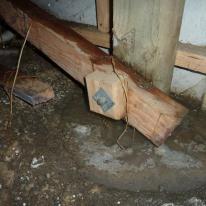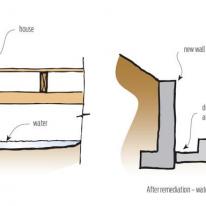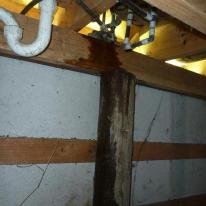Subfloor – ponding water
Listed under: plumbing, pipes, drains, Subfloor, foundation walls, retaining walls, moisture, leaks
Cause
Surface water flowing underneath the building if the subfloor ground level is lower than the ground or paving outside building perimeter, or if the ground slopes towards the building instead of away from it
Repair
- divert surface water away from the house by lowering the ground levels around the building and sloping the ground away from the house (see drawing). Install channels or sub-surface drains and discharge into a stormwater drain or soak pit.
- if constructing a soak pit, follow the guidance in New Zealand Building Code Verification Method E1/VM1. Be aware that construction of a soak pit may require a building consent
Cause
Blocked or overflowing stormwater drain or gulley trap discharging water under the house
Repair
- identify the source and location of the leak or the obstruction if possible. This may require calling in a licensed or certifying plumber. You can fix a broken downpipe that is discharging rainwater under the house, but if the leak is in a waste pipe or drain, under law that must be fixed by a licensed or certifying plumber.
Cause
Leaking drain or waste pipe in the subfloor space
Repair
- identify the source and location of the leak. This may require calling in a licensed or certifying plumber. You can fix a broken downpipe that is discharging rainwater under the house, but if the leak is in a waste pipe or drain, under law that must be fixed by a licensed or certifying plumber.
Cause
High water table so water does not readily drain away
Repair
-
ensure surface water drains away from the house by lowering the ground levels around the building and sloping the ground away from the house (see drawings above). Install channels or sub-surface drains and discharge into a stormwater drain or soak pit
-
lay polythene sheeting at least 0.25 mm thick to completely cover the ground under the house. Ensure that the ground is shaped so no water accumulates on top of the polythene. Polythene sheets should be lapped a minimum of 150 mm, preferably taped, and tightly butted up to foundation walls and piles. Weigh down the sheets with bricks or concrete to avoid them being displaced by ventilating air movement
-
ensure good subfloor ventilation with a minimum of 10 air changes per hour (the recommendation for a wet site). Specifically:
- provide not less than 3500 mm² of clear open subfloor venting (grilles or gaps between baseboards) for every 1 m² of floor area
- make ventilation openings high in the subfloor space, near to the underside of bearers
- spread vents evenly around the building perimeter to allow cross-ventilation
- no part of the subfloor should be more than 7.5 m from a ventilation opening.
Cause
Water getting through a retaining wall
Repair
- address water entry though a wall (see 'Moisture entry through retaining foundation walls')







